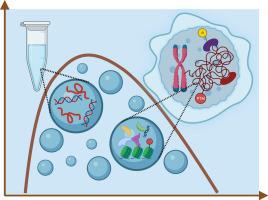当前位置:
X-MOL 学术
›
Adv. Colloid Interface Sci.
›
论文详情
Our official English website, www.x-mol.net, welcomes your feedback! (Note: you will need to create a separate account there.)
Liquid-liquid phase separation (LLPS) in DNA and chromatin systems from the perspective of colloid physical chemistry
Advances in Colloid and Interface Science ( IF 15.6 ) Pub Date : 2024-03-14 , DOI: 10.1016/j.cis.2024.103133 Lars Nordenskiöld , Xiangyan Shi , Nikolay Korolev , Lei Zhao , Ziwei Zhai , Björn Lindman
Advances in Colloid and Interface Science ( IF 15.6 ) Pub Date : 2024-03-14 , DOI: 10.1016/j.cis.2024.103133 Lars Nordenskiöld , Xiangyan Shi , Nikolay Korolev , Lei Zhao , Ziwei Zhai , Björn Lindman

|
DNA is a highly charged polyelectrolyte and is prone to associative phase separation driven by the presence of multivalent cations, charged surfactants, proteins, polymers and colloids. The process of DNA phase separation induced by positively charged species is often called DNA condensation. Generally, it refers to either intramolecular DNA compaction (coil-globule transition) or intermolecular DNA aggregation with macroscopic phase separation, but the formation of a DNA liquid crystalline system is also displayed. This has traditionally been described by polyelectrolyte theory and qualitative (Flory-Huggins-based) polymer theory approaches. DNA in the cell nucleus is packed into chromatin wound around the histone octamer (a protein complex comprising two copies each of the four histone proteins H2A, H2B, H3 and H4) to form nucleosomes separated by linker DNA. During the last decade, the phenomenon of the formation of biomolecular condensates (dynamic droplets) by liquid-liquid phase separation (LLPS) has emerged as a generally important mechanism for the formation of membraneless organelles from proteins, nucleic acids and their complexes. DNA and chromatin droplet formation through LLPS has recently received much attention by as well as studies that established the importance of this for compartmentalisation in the cell nucleus. Here, we review DNA and chromatin LLPS from a general colloid physical chemistry perspective. We start with a general discussion of colloidal phase separation in aqueous solutions and review the original (pre-LLPS era) work on DNA (macroscopic) phase separation for simpler systems with DNA in the presence of multivalent cations and well-defined surfactants and colloids. Following that, we discuss and illustrate the similarities of such macroscopic phase separation with the general behaviour of LLPS droplet formation by associative phase separation for DNA-protein systems, including chromatin; we also note cases of segregative association. The review ends with a discussion of chromatin LLPS and its physiological significance.
中文翻译:

从胶体物理化学角度研究DNA和染色质系统中的液-液相分离(LLPS)
DNA 是一种高电荷聚电解质,在多价阳离子、带电表面活性剂、蛋白质、聚合物和胶体的存在下易于发生缔合相分离。由带正电荷的物质引起的 DNA 相分离过程通常称为 DNA 凝聚。一般来说,它指的是分子内DNA压缩(螺旋球转变)或具有宏观相分离的分子间DNA聚集,但也显示DNA液晶体系的形成。传统上,这是通过聚电解质理论和定性(基于弗洛里-哈金斯)聚合物理论方法来描述的。细胞核中的 DNA 被包装到缠绕在组蛋白八聚体(一种蛋白质复合物,包含四种组蛋白 H2A、H2B、H3 和 H4 各两个拷贝)周围的染色质中,形成由接头 DNA 分隔的核小体。在过去的十年中,通过液-液相分离(LLPS)形成生物分子凝聚物(动态液滴)的现象已成为蛋白质、核酸及其复合物形成无膜细胞器的普遍重要机制。通过 LLPS 形成 DNA 和染色质液滴最近受到了广泛关注,研究也证实了其对于细胞核内区室化的重要性。在这里,我们从一般胶体物理化学的角度回顾 DNA 和染色质 LLPS。我们首先对水溶液中的胶体相分离进行一般性讨论,并回顾了在多价阳离子和明确的表面活性剂和胶体存在下,针对更简单的 DNA 系统的 DNA(宏观)相分离的原始(LLPS 时代之前)工作。接下来,我们讨论并说明了这种宏观相分离与通过 DNA-蛋白质系统(包括染色质)缔合相分离形成 LLPS 液滴的一般行为的相似之处;我们还注意到分离关联的案例。这篇综述最后讨论了染色质 LLPS 及其生理意义。
更新日期:2024-03-14
中文翻译:

从胶体物理化学角度研究DNA和染色质系统中的液-液相分离(LLPS)
DNA 是一种高电荷聚电解质,在多价阳离子、带电表面活性剂、蛋白质、聚合物和胶体的存在下易于发生缔合相分离。由带正电荷的物质引起的 DNA 相分离过程通常称为 DNA 凝聚。一般来说,它指的是分子内DNA压缩(螺旋球转变)或具有宏观相分离的分子间DNA聚集,但也显示DNA液晶体系的形成。传统上,这是通过聚电解质理论和定性(基于弗洛里-哈金斯)聚合物理论方法来描述的。细胞核中的 DNA 被包装到缠绕在组蛋白八聚体(一种蛋白质复合物,包含四种组蛋白 H2A、H2B、H3 和 H4 各两个拷贝)周围的染色质中,形成由接头 DNA 分隔的核小体。在过去的十年中,通过液-液相分离(LLPS)形成生物分子凝聚物(动态液滴)的现象已成为蛋白质、核酸及其复合物形成无膜细胞器的普遍重要机制。通过 LLPS 形成 DNA 和染色质液滴最近受到了广泛关注,研究也证实了其对于细胞核内区室化的重要性。在这里,我们从一般胶体物理化学的角度回顾 DNA 和染色质 LLPS。我们首先对水溶液中的胶体相分离进行一般性讨论,并回顾了在多价阳离子和明确的表面活性剂和胶体存在下,针对更简单的 DNA 系统的 DNA(宏观)相分离的原始(LLPS 时代之前)工作。接下来,我们讨论并说明了这种宏观相分离与通过 DNA-蛋白质系统(包括染色质)缔合相分离形成 LLPS 液滴的一般行为的相似之处;我们还注意到分离关联的案例。这篇综述最后讨论了染色质 LLPS 及其生理意义。



























 京公网安备 11010802027423号
京公网安备 11010802027423号